Biology | Life cycle | Impacts | Control | New York Distribution Map
Biology
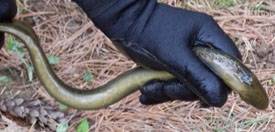
The sea lamprey (Petromyzon marinus) is one of four lamprey species found in the Lake Champlain Basin. Lamprey are eel-shaped fish with a skeleton made of cartilage and they belong to a relic (primitive) group of jawless fishes called Agnathans. The sea lamprey has smooth, scaleless skin and two fins on its back (dorsal fins). The sea lamprey is parasitic; it feeds on other fish, using a suction disk mouth filled with small sharp, rasping teeth and a file-like tongue. These are used by the sea lamprey to attach to a fish, puncture its skin, and drain its body fluids.
Life cycle
Sea lamprey have a complex life cycle. The first four years of their life are spent as ammocoetes [am-mah-seats] – a blind worm-like larval stage – in the soft bottom and banks of waters that flow into Lake Champlain. They then transform into the parasitic adult stage and enter the lake to feed on landlocked Atlantic salmon (salmon), lake trout and many other fish species; which they prefer due to their small scales and thin skin. After twelve (12) to twenty (20) months in the lake the adults migrate back into the streams flowing into the lake to spawn, after which the adults die.
Lampreys in Lake Champlain
Moderate numbers of sea lampreys were first noted in Lake Champlain in 1929. The sea lamprey has been considered a non-native invasive species that entered Lake Champlain during the 1800s through the Hudson/Champlain Canal. Recent genetic studies indicate that the sea lamprey may be native to Lake Champlain.
Three other lamprey species are found in the Lake Champlain Basin. Two species are non-parasitic, and while the third species is parasitic, it does not have a significant impact on the Lake Champlain fish community.
Whether the sea lamprey is native to Lake Champlain or not, it is having detrimental impacts on the Lake Champlain fisheries, ecosystem, and human residents that are very significant.
Impacts
Sea lamprey have a major detrimental impact on the Lake Champlain fish community, the Lake Champlain Basin ecosystem, the anglers that fish Lake Champlain, and the many people throughout the watershed whose livelihood is directly or indirectly supported by the fishing and tourist industry.
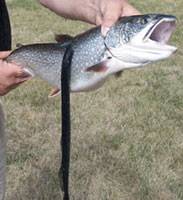
Adult sea lamprey attach to a host fish, rasp and puncture its skin, and drain its body fluids, often killing the host fish. Their preferred hosts are salmon, lake trout and other trout species, however they also feed on other fish species, including lake whitefish, walleye, northern pike, burbot, and lake sturgeon. The lake sturgeon is listed as a threatened species in New York and an endangered species in Vermont and it is likely that sea lamprey are affecting their survival.
Impacts on Host Fish
Most sea lamprey hosts are native fish species that have been part of the Lake Champlain Basin ecosystem for thousands of years. Additionally many of these fish species are important sportfish, highly prized and sought after by local and visiting anglers.
Prior to any control measures, angler catches of lake trout and salmon in Lake Champlain were a fraction of catches in similar lakes, despite intensive stocking efforts. High wounding rates indicated that sea lamprey were having a significant impact on the lake trout and salmon populations, and were preventing the restoration of these native fish species to Lake Champlain.
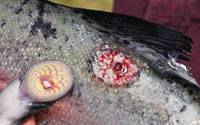
Studies on the Great Lakes show a 40 to 60 percent mortality rate for fish attacked by sea lamprey. Other studies found that a single sea lamprey can kill 40 or more pounds of fish during its adult life. The abundance of sea lamprey were obviously having significant impacts on Lake Champlain’s fishery and ecosystem.
Impacts on Local Economy
Poor fishing caused many anglers to seek fishing opportunities elsewhere. A study estimated that 29.4 million dollars in economic benefits to businesses and residents of the Lake Champlain Basin were lost due to the impacts of sea lamprey.
Control
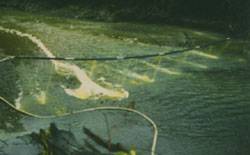
Due to the severity of the impacts that sea lamprey have on the Lake Champlain fishery and ecosystem, and the social and economic impacts on the people who live in the Lake Champlain Basin, it has been determined that sea lamprey populations should be controlled. The federal and state governments, the agencies that manage Lake Champlain, the various organizations that are concerned with Lake Champlain and the people that live in the Lake Champlain Basin generally agree that it would be irresponsible not to control the sea lamprey population.
The New York State Department of Environmental Conservation, the Vermont Department of Fish and Wildlife and the United States Fish and Wildlife Service formed a cooperative and began an integrated control program to reduce the sea lamprey population in Lake Champlain to an acceptable level. The program is not attempting to eliminate the sea lamprey from Lake Champlain, but rather to reduce the impacts of sea lamprey on the lake’s fishery and restore balance to the ecosystem.
Control Efforts
Physical methods of control include the use of barriers to prevent adult sea lamprey from migrating up waterways to spawn and traps to capture adult sea lamprey before they can spawn.
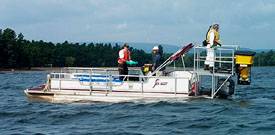
However, the most significant and effective form of control has been the treatment of tributaries and deltas with lampricides – TFM in tributaries and Bayluscide on deltas. The lampricides target the larval sea lamprey, killing them before they can transform into their parasitic adult form.
It should be noted that after years of study in Lake Champlain, the Great Lakes, and other places where sea lamprey are controlled by using lampricides, fisheries managers have concluded that the lampricides have little or no known permanent effect on populations of non-target species present in the treatment areas.
Control Program
Evaluation of an eight year experimental sea lamprey control program that took place in Lake Champlain in the 1990s documented significant benefits for fish and anglers. These benefits included decreases in wounding rates on trout and salmon, increases in weight and survival rates of lake trout, increases in angler catch rates of lake trout and a benefit to cost ratio of 3.5 to 1.
At the end of the eight year experimental sea lamprey control program, a limited, three-year interim sea lamprey control program was undertaken from 1998 to 2000. After a thorough environmental review, a long term sea lamprey control program began in 2002.
Fish sampling programs, salmon returns to fish ladders, angler surveys and sampling of larval sea lamprey are used to measure the effectiveness of the control program. The control program may be expanded to other streams and delta areas if significant sea lamprey populations develop in them.
Assessments

Assessments of sea lamprey populations are made before any control measures are undertaken and afterwards to assist in determining the effectiveness of the controls. Field staff, using a variety of capture methods, sample both adult and larval sea lamprey from streams and deltas to determine the presence and density of sea lamprey populations. This information is used to determine which streams or deltas are in need of control measures and which control measures to use.
Scientists and fish managers have considered, and continue to consider, other methods to reduce sea lamprey impacts. These include the use of pheromones (chemical attractants naturally produced by lamprey) to capture adult sea lamprey, the release of sterile males to disrupt spawning, and the stocking of lamprey-resistant strains of fish.



New York Distribution Map
This map shows confirmed observations (green points) submitted to the NYS Invasive Species Database. Absence of data does not necessarily mean absence of the species at that site, but that it has not been reported there. For more information, please visit iMapInvasives.



